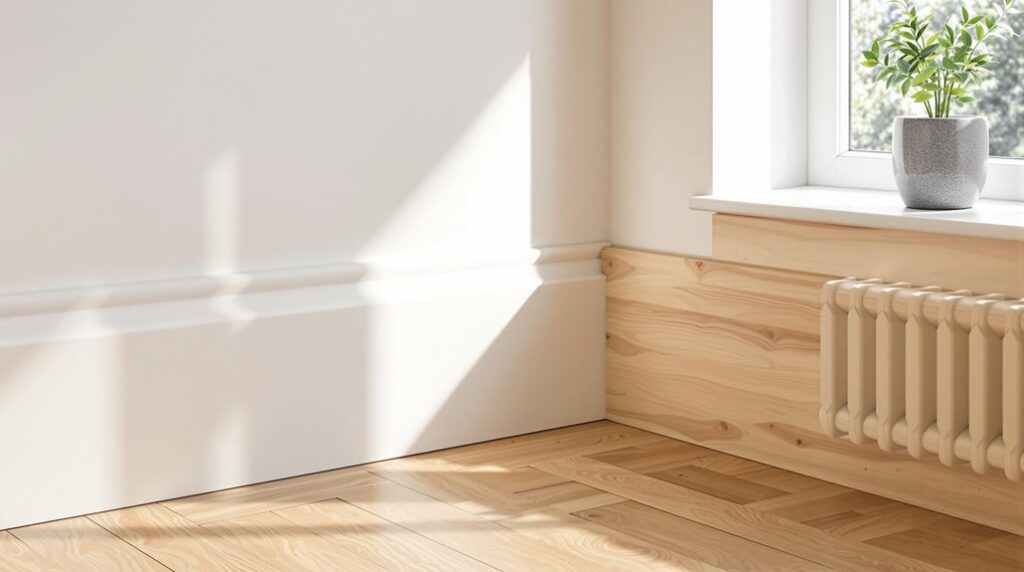I’ve fitted hundreds of metres of skirting in UK homes, and I can tell you that choosing between MDF and pine isn’t as straightforward as most people think. While your budget might point you toward MDF’s lower upfront costs, I’ve seen homeowners regret their choice when moisture damage strikes their ground-floor rooms. There’s more to this decision than price alone, and the wrong choice could cost you considerably more in the long run.
Key Takeaways
- MDF costs £20-£40 per metre and installs faster, while pine ranges £25-£50 but requires additional primer and preparation work.
- MDF offers superior day-to-day durability with uniform structure, whereas pine dents easily and has weak points at knots.
- Pine handles moisture better allowing localized repairs, while standard MDF swells and requires complete replacement when water-damaged.
- MDF arrives pre-primed needing only undercoat plus topcoat, while pine requires thorough sanding and two undercoats for painting.
- Choose MDF for high-traffic areas and cost-effectiveness, or pine for bathrooms and traditional properties requiring natural wood character.
Cost Analysis: MDF Vs Pine Skirting Board Prices
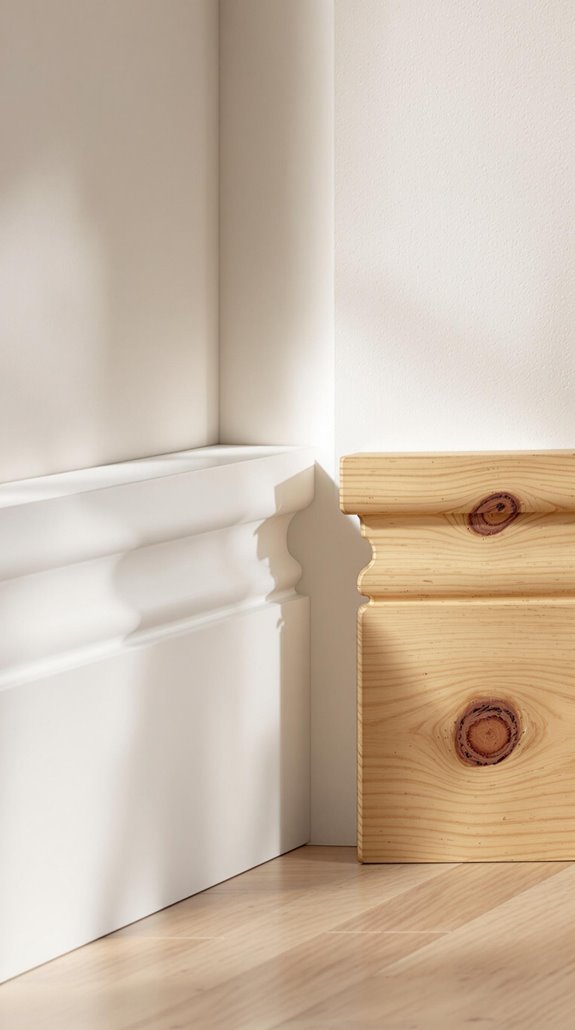
When I’m pricing out skirting board projects, I’ve found that MDF typically runs £20-£40 per metre while pine costs £25-£50 per metre—but the real savings come from understanding the hidden costs.
Here’s what I’ve learned from experience: MDF comes pre-primed, so you’re straight into painting without prep work. Pine? You’ll need primer, plus extra time filling knots and sanding for a smooth finish. That’s additional material costs and labour hours.
Professional installation averages £150-£200 per day, and since MDF installs faster with less prep, you’re looking at genuine time savings. If you’re going for a painted finish, MDF wins on total project cost. Pine only justifies its premium when you’re showcasing natural wood grain with stains or varnish. However, pine can actually be cheaper based on the quality grade and supplier you choose. Additionally, considering regional price variations in skirting board materials can help you make a more informed decision on your renovation budget.
Durability and Strength Comparison
After installing hundreds of metres of both materials, I’ve discovered that MDF consistently outperforms pine in day-to-day durability tests. Pine’s softwood nature means it dents easily—I’ve seen door handles and furniture legs leave permanent marks within months. MDF’s compressed fiber composition creates a harder surface that withstands these impacts brilliantly.
The real game-changer is structural integrity. Pine’s knots create weak points that can loosen over time, leaving unsightly holes. I’ve had to replace entire pine sections because of this. MDF’s uniform structure eliminates these vulnerabilities completely.
Temperature and humidity changes are pine’s worst enemy. I’ve witnessed pine skirting warp dramatically in poorly ventilated rooms, while MDF maintains its shape. Pine can also be repaired in situ when damage does occur, offering some flexibility for maintenance. For reliability, MDF wins hands down.
Moisture Resistance Performance
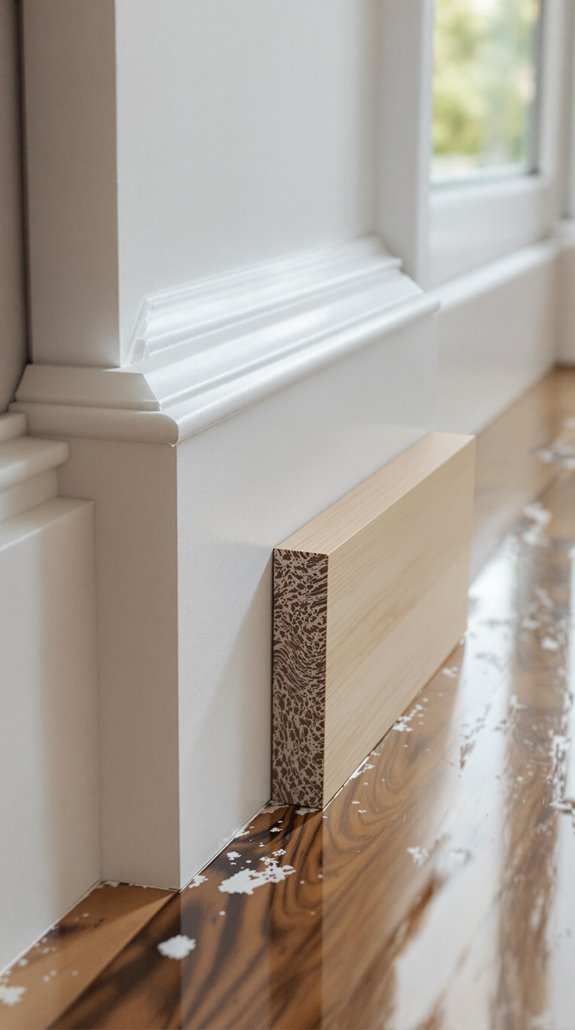
Building on that durability foundation, moisture exposure tells a completely different story between these materials. I’ve seen standard MDF swell within hours of water contact, creating irreversible damage that’ll have you replacing entire sections. Pine handles minor moisture better naturally, though you’ll still need proper sealing to prevent warping.
Here’s what really matters: moisture-resistant MDF can handle typical bathroom humidity when fully primed and painted, but cut edges absorb water 70% faster than factory surfaces. Pine outperforms standard MDF in damp conditions and allows localized repairs if warping occurs.
Both materials need immediate water cleanup and proper caulking at floor joints. For high-humidity spaces, I’d choose sealed pine over standard MDF every time. However, moisture-resistant MDF performs well in average bathroom conditions when properly sealed, though it’s not suitable for wet rooms or areas prone to flooding.
Painting and Finishing Requirements
While both materials accept paint beautifully, their prep work couldn’t be more different. I’ve found MDF arrives pre-primed, giving you a head start, but you’ll need to seal those cut edges religiously to prevent moisture swelling. Pine demands more upfront effort – thorough sanding, cleaning, and specialized stain-blocking primer to handle those troublesome knots. Remember that proper preparation techniques are essential for a flawless finish.
Here’s my painting approach: MDF needs an undercoat plus topcoat, while pine requires two undercoats for durability. Both benefit from 220-grit sanding between coats – don’t skip this step if you want professional results. When rolling MDF, backbrush immediately to eliminate stipple marks.
For maintenance, MDF just needs light deglossing before repainting, while pine may require fresh primer for color changes. Apply multiple thin coats rather than one thick application to achieve the most professional finish on either material.
Aesthetic Appeal and Visual Differences
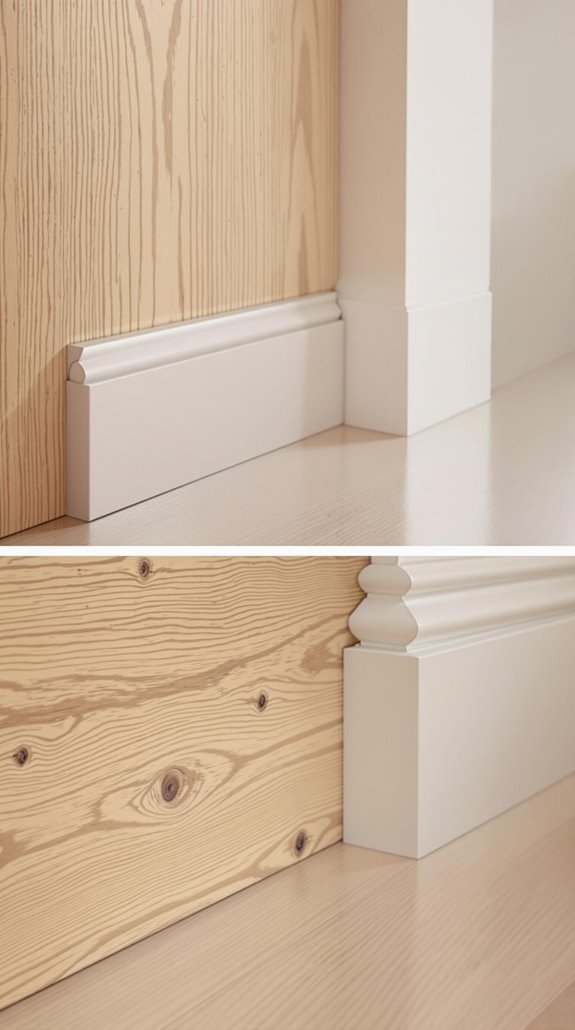
The texture difference between MDF and pine skirting hits you immediately – it’s like comparing a perfectly smooth countertop to a piece of driftwood. MDF gives you that flawless, uniform surface that screams modern precision, while pine brings natural grain patterns that tell their own story.
I’ve found pine’s knots and imperfections either make or break a room’s character. They’re perfect for period properties where authenticity matters, but they’ll stick out like a sore thumb in contemporary spaces. MDF’s clean lines suit minimalist interiors beautifully, though it lacks pine’s organic warmth.
Here’s the kicker: once you paint pine, you lose most visual distinction from MDF. That natural grain disappears, making your material choice purely functional rather than aesthetic. Pine offers diverse styles like chamfer, bullnose, and ogee profiles that can complement both traditional and modern design schemes.
Environmental Impact and Sustainability
When you’re weighing up skirting materials, the environmental story becomes surprisingly complex – and it’s not always what you’d expect.
I’ve found that MDF actually champions waste reduction by utilizing timber industry byproducts, keeping wood fibers from landfills. However, its resin-heavy production demands high energy consumption, and standard grades suffer irreversible water damage, shortening lifespan considerably. Additionally, the use of eco-friendly materials in construction can greatly reduce overall environmental impact.
Pine presents a cleaner manufacturing profile with minimal chemical processing, plus you can repair it in-situ rather than replacing entire sections. The natural aesthetic of pine also means you’re getting warm tones and visible grain patterns that enhance your home’s charm without requiring synthetic finishes. UK-sourced pine also slashes transportation emissions compared to imported alternatives.
Your best environmental bet? FSC-certified pine from British forests offers renewable sourcing with natural biodegradability. For MDF enthusiasts, seek E1-compliant boards with recycled content – they’re becoming increasingly available through eco-conscious suppliers nationwide.
Installation Considerations and Ease of Use
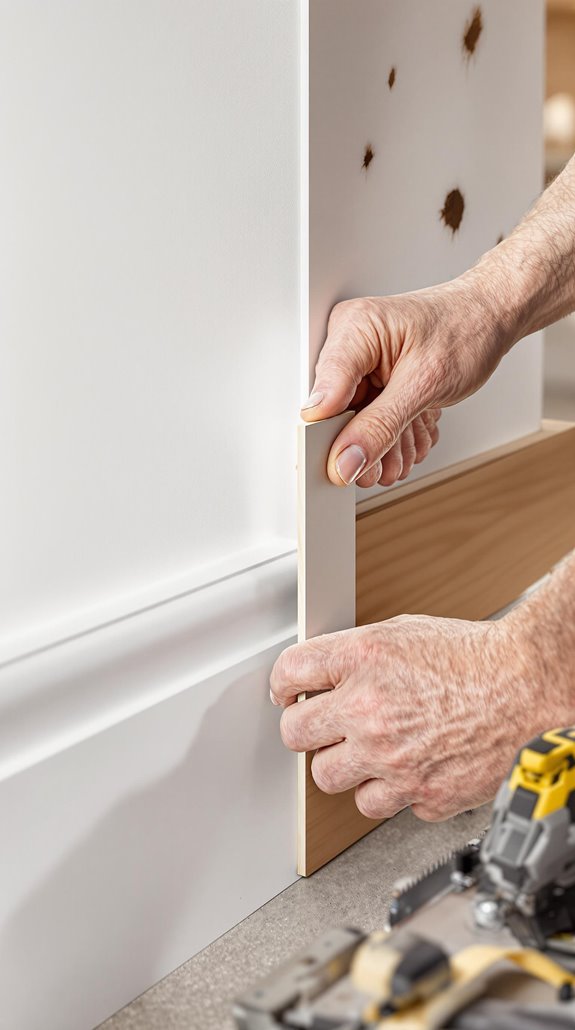
As someone who’s installed hundreds of metres of skirting, I can tell you that material choice dramatically affects your workflow and frustration levels. MDF cuts like butter with any decent saw, creating clean profiles without splintering—perfect for those intricate Victorian-style mouldings. Pine, however, requires sharper blades and more patience to avoid tear-out.
Here’s where MDF shines: it comes pre-primed, so you’re painting straight away. Pine needs proper priming first, adding hours to your job. But here’s the trade-off—MDF’s density makes it heavier to handle, especially on longer runs. Pine’s lighter weight means less strain on your back during installation. Additionally, choosing the right materials can lead to budget-friendly renovations that enhance your home’s appeal without breaking the bank.
For moisture-prone areas like bathrooms, stick with pine. MDF will swell and warp despite your best efforts, creating callbacks you’ll regret. Pine is also easier to repair if you do encounter damage during or after installation.
Maintenance Requirements Over Time
Long-term maintenance costs will make or break your skirting decision, and I’ve learned this lesson through years of callbacks and warranty claims. MDF demands less initial prep since it’s pre-primed, but here’s the catch—moisture will destroy it. I’ve replaced entire MDF installations after kitchen floods or bathroom steam damage.
Pine requires knotting solution and proper undercoating upfront, but you’ll thank yourself later. When pine gets dinged or worn, you can sand it down and refinish it multiple times. MDF? Once it’s damaged, you’re replacing sections. With proper maintenance, pine skirting can last for generations, making it a worthwhile investment despite the higher upfront costs.
For kitchens and bathrooms, pine wins hands-down with proper sealing. MDF works brilliantly in dry living areas where its smooth finish stays pristine. Choose based on your room’s humidity levels—trust me on this one.
Best Room Applications for Each Material

Though every room presents unique challenges, I’ve discovered that matching your skirting material to each space’s specific demands saves you headaches and money down the line.
For kitchens, I recommend moisture-resistant MDF grades near splash zones, but pine works brilliantly around sinks with proper sealing. Additionally, incorporating space-saving designs such as folding doors can help optimize the kitchen layout. In living areas, MDF’s impact resistance handles high-traffic punishment whilst delivering smooth painted finishes, though pine’s natural grain adds warmth to formal spaces.
Bathrooms favour pine’s natural moisture tolerance over standard MDF, but moisture-resistant MDF offers budget-friendly performance when fully sealed. Moreover, selecting the right door type can greatly enhance the functionality of these smaller spaces. Period properties benefit from pine’s authentic grain patterns and superior stain acceptance, whilst MDF replicates intricate profiles cost-effectively.
For hallways, MDF withstands constant scuffs and impacts, making it my go-to choice for narrow corridors where durability trumps aesthetics. HDF provides even greater density and moisture resistance, making it an excellent upgrade option for demanding applications.
Making the Right Choice for Your Property
Room selection represents just one piece of the skirting puzzle – your property’s specific circumstances ultimately determine which material delivers the best long-term value. I’d assess your budget first – MDF wins on upfront costs, especially pre-primed options that’ll save you prep time. Consider your home’s moisture levels; bathrooms and kitchens favour moisture-resistant MDF over pine’s vulnerability to warping. If you’re planning to paint, MDF’s smooth finish trumps pine’s natural inconsistencies. However, pine’s your only choice for stained or natural finishes that showcase wood grain.
Additionally, investing in energy-efficient improvements can enhance the overall value of your renovation, making it worthwhile to consider how your skirting choices fit into your broader home efficiency goals. Factor in your DIY skills too – pine cuts easier but requires more prep work, while MDF demands careful handling to avoid chipping. For rental properties, MDF’s durability justifies the investment; for period homes, pine maintains authentic character. Quality suppliers offer various profile options to complement different interior design styles throughout your home.
Conclusion
After years of fitting both materials, I’d choose MDF for utility areas where you need durability and easy maintenance, while pine works brilliantly in living spaces where you want that natural warmth. Don’t overthink it—match the material to your room’s purpose and your skill level. If you’re handy with tools and enjoy working with wood, pine’s worth the extra effort. Otherwise, MDF’s your reliable, cost-effective solution.
References
- https://www.homebuilding.co.uk/advice/mdf-or-pine-skirting
- https://metresdirect.co.uk/blogs/how-to-guide/the-best-material-for-skirting-boards
- https://www.daniellelevy.co.uk/blogmas-guest-post-skirting-board/
- https://www.youtube.com/watch?v=YVlETxIwSGg
- https://www.tradesuperstoreonline.co.uk/blogs/resources/choosing-between-mdf-softwood-or-solid-wood-for-skirting-and-architrave-a-comprehensive-guide
- https://www.myjobquote.co.uk/costs/replacing-skirting-and-architrave
- https://www.jewson.co.uk/timber/mouldings-planed-timber/skirting
- https://forum.buildhub.org.uk/topic/27672-mdf-vs-pine-skirting-board/
- https://mdfskirtingworld.co.uk/blog/cost-of-skirting-boards/
- https://singletrackworld.com/forum/off-topic/replacement-skirting-pine-or-mdf/

